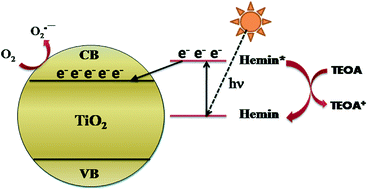New insights into the origin of the visible light photocatalytic activity of Fe(iii) porphyrin surface anchored TiO2
Abstract
In order to utilize visible light more effectively in photocatalytic reactions, the surfaces of TiO2 nanoparticles are sensitized by Hemin molecules (H–TiO2) and the catalyst is characterized by various analytical techniques like powder X-ray diffraction (PXRD), Fourier transform infrared spectroscopy (FTIR), UV-Visible absorption spectroscopy, X-ray photoelectron spectroscopy (XPS), field emission scanning electron microscopy (FESEM), transmission electron microscopy (TEM) with an energy-dispersive X-ray (EDX) technique, BET surface area measurements and thermogravimetric analysis (TGA). The results strongly confirm the chemisorption of Hemin molecules on the TiO2 surface through O![[double bond, length as m-dash]](https://www.rsc.org/images/entities/char_e001.gif) C–O–Ti bonds. The photocatalytic activity of H–TiO2 was investigated by the degradation of 4-nitrophenol as a model compound in an aqueous solution under solar light irradiation with the assistance of an appropriate amount of a sacrificial electron donor. The enhanced activity of H–TiO2 confirms the sensitization process. Intermediate products were identified by HPLC analysis and a possible degradation reaction mechanism was proposed. The development of this porphyrin-based photocatalyst provides an alternative approach in harnessing visible solar light and shows promise for waste water treatment in future industrial applications.
C–O–Ti bonds. The photocatalytic activity of H–TiO2 was investigated by the degradation of 4-nitrophenol as a model compound in an aqueous solution under solar light irradiation with the assistance of an appropriate amount of a sacrificial electron donor. The enhanced activity of H–TiO2 confirms the sensitization process. Intermediate products were identified by HPLC analysis and a possible degradation reaction mechanism was proposed. The development of this porphyrin-based photocatalyst provides an alternative approach in harnessing visible solar light and shows promise for waste water treatment in future industrial applications.


 Please wait while we load your content...
Please wait while we load your content...